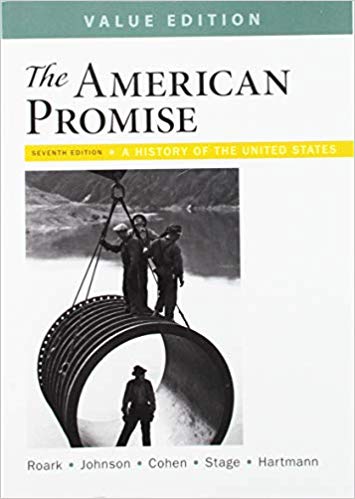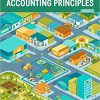Test Bank for Understanding the American Promise 7th COMBINED by Roark
$35.00 Original price was: $35.00.$26.50Current price is: $26.50.
Test Bank for Understanding the American Promise 7th COMBINED by Roark
Instant download Test Bank for Understanding the American Promise 7th COMBINED by Roark pdf docx epub after payment.

Product details:
- ISBN-10 : 1319042244
- ISBN-13 : 978-1319042240
- Author: James L. Roark; Susan M. Hartmann
Understand what you’re reading better through the inquiry-based presentation of history which drives you to take more active approach to learning in Understanding the American Promise, Combined Volume.
Table of contents:
Preface
Versions and Supplements
Maps and Figures
1. Ancient America, Before 1492
An American Story: An archaeological dig uncovers ancient North Americans traditions
Why do historians rely on the work of archaeologists?
When and how did humans migrate into North America?
African and Asian Origins
Paleo-Indian Hunters
When and why did Archaic hunter-gatherers inhabit ancient America?
Great Plains Bison Hunters
Great Basin Cultures
Pacific Coast Cultures
Eastern Woodland Cultures
How did agriculture influence ancient American cultures?
Southwestern Cultures
Woodland Burial Mounds and Chiefdoms
What ancient American cultures inhabited North America in the 1490s?
Eastern and Great Plains Peoples
Southwestern and Western Peoples
Cultural Similarities
How did the Mexican empire amass power and riches?
Conclusion: How did ancient Americans shape their world and ours?
Chapter Review
2. Europeans Encounter the New World, 1492–1600
An American Story: Queen Isabella of Spain supports Columbus’s risky plan to sail west across the Atlantic
Why did Europeans launch explorations in the fifteenth century?
Mediterranean Trade and European Expansion
A Century of Portuguese Exploration
What did Spaniards discover in the western Atlantic?
The Explorations of Columbus
The Geographic Revolution and the Columbian Exchange
How did Spaniards conquer and colonize New Spain?
The Conquest of Mexico
The Search for Other Mexicos
Spanish Outposts in Florida and New Mexico
New Spain in the Sixteenth Century
The Toll of Spanish Conquest and Colonization
How did New Spain influence Europe?
The Protestant Reformation and the Spanish Response
Europe and The Spanish Example
Conclusion: What did the New World Promise Europeans?
Chapter Review
3. The Southern Colonies in the Seventeenth Century, 1601–1700
An American Story: A young woman from England travels to America as a servant
How did settlers encounters with Native Americans and the Chesapeake environment shape the colony of Virginia?
The Fragile Jamestown Settlement
Cooperation and Conflict between Natives and Newcomers
From Private Company to Royal Government
How did tobacco influence Chesapeake society?
Tobacco Agriculture
A Servant Labor System
The Rigors of Servitude
Cultivating Land and Faith
Why did Chesapeake society change by the 1670s?
Social and Economic Polarization
Government Policies and Political Conflict
Bacon’s Rebellion
Why did a slave labor system develop in England’s southern colonies?
Indians Revolt in New Mexico and Florida
Religion and Revolt in the Spanish Borderland
The West Indies: Sugar and Slavery
Carolina: A West Indian Frontier
Slave Labor Emerges in the Chesapeake
Conclusion: How did export crops contribute to the growth of the southern colonies?
Chapter Review
4. The Northern Colonies in the Seventeenth Century, 1601–1700
An American Story: Roger Williams is banished from Puritan Massachusetts
Why did Puritans emigrate to North America?
Puritan Origins: The English Reformation
The Pilgrims and Plymouth Colony
The Founding of Massachusetts Bay Colony
How did New England society change during the seventeenth century?
Church, Covenant, and Conformity
Government by Puritans for Puritanism
The Splintering of Puritanism
Religious Controversies and Economic Changes
How did the Middle Colonies differ from New England and the southern colonies?
From New Netherland to New York
New Jersey and Pennsylvania
Toleration and Diversity in Pennsylvania
How did the English empire influence the colonies?
Royal Regulation of Colonial Trade
King Philip’s War and the Consolidation of Royal Authority
Conclusion: Was there an English model of colonization in North America?
Chapter Review
5. Colonial America in the Eighteenth Century, 1701–1770
An American Story: The Robin Johns’ horrific turns of fortune in the Atlantic slave trade
How did the British North American colonies change during the eighteenth century?
What changed in New England life and culture?
Natural Increase and Land Distribution
Farms, Fish, and Atlantic Trade
Why did the Middle Colonies grow rapidly?
German and Scots-Irish Immigrants
“God Gives All Things to Industry”: Urban and Rural Labor
Why did slavery come to define the Southern Colonies?
The Atlantic Slave Trade and the Growth of Slavery
Slave Labor and African American Culture
Tobacco, Rice, and Prosperity
What unified colonists in British North America during the eighteenth century?
Commerce and Consumption
Religion, Enlightenment, and Revival
Trade and Conflict in the North American Borderlands
Colonial Politics in the British Empire
Conclusion: Why did British North American colonists develop a dual identity?
Chapter Review
6. The British Empire and the Colonial Crisis, 1754-1775
An American Story: Loyalist governor Thomas Hutchinson stands his ground How did the Seven Years’ War lay the groundwork for colonial crisis?
French-British Rivalry in the Ohio Country
The Albany Congress
The War and Its Consequences
Pontiac’s Rebellion War and the Proclamation of 1763
How did imperial authorities and British colonists differ in their views about the legitimacy of taxing the colonies?
Grenville’s Sugar Act
The Stamp Act
Resistance: From Colonial Assemblies to Crowd Politics
Liberty and Property
Why did the colonial crisis worsen after the repeal of the Stamp Act?
The Townshend Duties
Nonconsumption and the Daughters of Liberty
Military Occupation and “Massacre” in Boston
How did British policy and colonial response interact after the repeal of the Townshend Duties to lead to open rebellion?
The Calm before the Storm
Tea in Boston Harbor
The Coercive Acts
Beyond Boston: Rural New England
The First Continental Congress
How did enslaved people in the colonies react to the stirrings of revolution?
Lexington and Concord
Rebelling against Slavery
Conclusion: What changes did the American colonists want in 1775?
Chapter Review
7. The War for America, 1775-1783
An American Story: Deborah Sampson masquerades as a man to join the Continental army
What eventually persuaded British North American colonists to support independence?
Assuming Political and Military Authority
Pursuing Both War and Peace
Thomas Paine, Abigail Adams, and the Case for Independence
The Declaration of Independence
How did the military objectives of each side shape the course of the war’s early years?
The American Military Forces
The British Strategy
Quebec, New York, and New Jersey
How did the war transform the home front?
Patriotism at the Local Level
The Loyalists
Who Is a Traitor?
Financial Instability and Corruption
From Rebellion to Revolution
How did the American Revolution expand to become a war among continental and global powers?
Burgoyne’s Army and the Battle of Saratoga
The War in the West: Indian Country
The French Alliance
What were the principal causes of the British defeat?
Georgia and South Carolina
Treason and Guerrilla Warfare
Surrender at Yorktown
The Losers and the Winners
Conclusion: Why did the British lose the American Revolution?
Chapter Review
8. Building a Republic, 1775-1789
An American Story: James Madison comes of age in the midst of revolution
What kind of government did the Articles of Confederation create?
Confederation and Taxation
The Problem of Western Lands
Running the New Government
How was republican government implemented?
The State Constitutions
Who Are “the People”?
Equality and Slavery
Why did the Articles of Confederation fail?
The War Debt and the Newburgh Conspiracy
The Treaty of Fort Stanwix
The Northwest Territory
The Requisition of 1785 and Shays’s Rebellion, 1786–1787
How did the Constitution change the nation’s form of government?
From Annapolis to Philadelphia
The Virginia and New Jersey Plans
Checks and Balances
Why did so many Americans object to the Constitution?
The Federalists
The Antifederalists
The Federalist Persuasion
Conclusion: What was the “republican remedy”?
Chapter Review
9. The New Nation Takes Form, 1789–1800
An American Story: Alexander Hamilton becomes a polarizing figure in the 1790s
What were the sources of political stability in the 1790s?
Washington Inaugurates the Government
The Bill of Rights
The Republican Wife and Mother
Why did Hamilton’s economic policies provoke such controversy?
Agriculture, Transportation, and Banking
The Public Debt and Taxes
The First Bank of the United States and the Report on Manufactures
What threats did the United States face in the West?
Western Discontent and the Whiskey Rebellion
Creeks in the Southwest
Ohio Indians in the Northwest
What threats did the United States face in the Atlantic World?
France and Britain: Toward Neutrality
The Jay Treaty
The Haitian Revolution
How did partisan rivalries shape the politics of the late 1790s?
Federalists and Republicans
The XYZ Affair
The Alien and Sedition Acts
Conclusion: Why did the United States form political parties in a decade when it achieved political stability?
Chapter Review
10. Republicans in Power, 1800-1828
An American Story: Tecumseh attempts to forge a pan-Indian confederacy
What was the Revolution of 1800?
Turbulent Times: Election and Rebellion
The Jeffersonian Vision of Republican Government
Dangers Overseas: The Barbary Wars
How did the Louisiana Purchase affect the United States?
The Louisiana Purchase
The Lewis and Clark Expedition
Osage and Comanche Indians
What led to the War of 1812?
Impressment and Embargo
Tecumseh and Tippecanoe
Washington City Burns: The British Offensive
How did the civil status of free American women and men differ in the early Republic?
Dolley Madison and Social Politics
Women and the Law
Women and Church Governance
Female Education
Why did partisan conflict increase during the administrations of Monroe and Adams?
From Property to Democracy
The Missouri Compromise
The Monroe Doctrine
The Election of 1824
The Adams Administration
Conclusion: How did republican simplicity become complex?
Chapter Review
11. The Expanding Republic, 1815-1840
An American Story: The Grimké sisters speak out against slavery
What Economic Developments Reshaped the U.S. Economy after 1815?
Improvements in Transportation
Factories, Workingwomen, and Wage Labor
Bankers and Lawyers
Booms and Busts
How did new practices of party politics shape Andrew Jackson’s election and agenda?
Popular Politics and Partisan Identity
The Election of 1828 and the Character Issue
Jackson’s Democratic Agenda
What was Andrew Jackson’s impact on the presidency?
Indian Policy and the Trail of Tears
The Tariff of Abominations and Nullification
The Bank War and Economic Boom
How did social and cultural life change in the 1830s?
Separate Spheres
The Second Great Awakening and Moral Reform
Organizing against Slavery
What political and economic events dominated Martin Van Buren’s Presidency?
The Politics of Slavery
Elections and Panics
Conclusion: The Age of Jackson or the era of reform?
Chapter Review
12. The North and West, 1840-1860
An American Story: Abraham Lincoln struggles to survive in antebellum America
Why did “industrial evolution” occur?
Agriculture and Land Policy
Manufacturing and Mechanization
Railroads: Breaking the Bonds of Nature
How did the free-labor ideal explain economic inequality?
The Free-Labor Ideal
Economic Inequality
Immigrants and the Free-Labor Ladder
What spurred westward expansion?
Manifest Destiny
Oregon and the Overland Trail
The Mormon Exodus
The Mexican Borderlands
Why did the United States go to war with Mexico?
The Politics of Expansion
The Mexican-American War, 1846–1848
Victory in Mexico
Golden California
People also search:
Understanding the American Promise 7th
Understanding the American Promise 7th pdf
Understanding the American Promise
what was the american promise
what does the american dream promise
Related products
Test Bank
Test Bank for Decision Support and Business Intelligence Systems, 9th Edition: Efraim Turban
Test Bank
Test Bank for Operating Systems: Internals and Design Principles, 7th Edition: William Stallings











